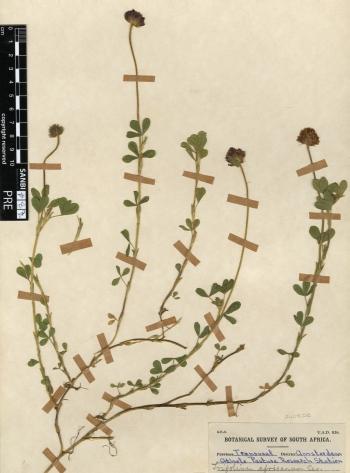Trifolium africanum
Trifolium africanum Ser.
Family: Fabaceae
Common names: erasmus clover, wild clover (Eng.); wildeklawer (Afr.); mmusapelo, moroko, musapelo, mokopshwe, mootsapelo, moqoiqoi, moqophi, (Sesotho)
Introduction
It is impossible not to spot this brick-red clover plant from the Grassland Biome, as it stands out because of the stunning bright colour of its flowers.

Description
Description
A perennial plant 0.10–0.25 m tall and densely covered with hairs. The stems of the plant are numerous and erect, or sometimes prostrate.

The leaves have paired stipules that are triangular-lanceolate in shape, leaf stalks that are almost as long as the leaflets, and leaflets that are oblanceolate, oblong-lanceolate to lanceolate in shape, and usually 10–20(–40) × 4–8 mm long.

Inflorescences are globose, 10–15(–20) mm wide and are made up of numerous flowers. The flowers are 8–10 mm long and have purple to brick-red corolla lobes. The standard is longer than the wings and keel.

Pods stick out of the persistent calyx tube and each pod contains 2 seeds. Seeds are ovoid, about 2 mm long, and yellowish green. The flowering time of Trifolium africanum is in summer (November–March).
Conservation Status
Status
According to the Red List of South African plants, Trifolium africanum is considered as Least Concern (LC), because it is widespread.
Distribution and habitat
Distribution description
The genus Trifolium has a cosmopolitan distribution, occurring from western Africa, to southern America and to the Mediterranean in the north, where it is restricted to alpine zones and montane grasslands.
The distribution of Trifolium africanum in South Africa is based on the examination of specimens in the National Herbarium in Pretoria (PRE). The plants can be found in the Gauteng, Free State, Western Cape, Eastern Cape and Kwa-Zulu Natal Provinces. It is also found in Botswana, Lesotho, Namibia and Swaziland. It occurs in damp areas, such as wetlands and stream banks, or disturbed areas.

Derivation of name and historical aspects
History
The generic name is derived from the Latin words tri, which means ‘three’ and folium, which means ‘leaf’. It is named to describe the characteristic trifoliate leaflets. The species name refers to the continent, Africa, in Latin.
Trifolium has ± 250 species worldwide and 19 in southern Africa, of which some are naturalised and 9 are indigenous. The genus is one of the economically important genera, as many species are widely cultivated as fodder plants and green manure, including some that are either naturalised or native in South Africa.
Ecology
Ecology
Trifolium africanum have colourful flowers that attract insects to assist in pollination. Most insects that visit the flowers have long probosces, for example honey bees, bumble bees and certain butterflies and moths belonging to the Lepidoptera.
Uses
Use
Trifolium africanum is used by the Basotho people as a medicinal plant and a charm. Root infusions treat heart related ailments, high blood pressure and a sore throat. It is consumed by women to persuade and charm.
Growing Trifolium africanum
Grow
No cultivation techniques are documented for this plant. Cultivation techniques as described for Trifolium repens may apply. The plant grows well in a partially shaded spot which has neutral or slightly acidic soil. It requires very little maintenance, can be watered twice a week in summer and once in winter. It is a frost hardy plant.
Propagate in spring or summer by seeds. Prepare soil by mixing it with fertilisers that are rich in phosphorus and potassium. Plant the seeds and cover them lightly with soil. Once the seedlings are strong enough, transplant them to bigger pots. Clovers are usually attacked by bacteria and viruses which cause brown spots and powdery mildew on leaves.
References
- Harvey, W.H. 1862. Leguminosae. In W.T. Thiselton-Dyer, Flora capensis, Vol. 2. Reeve and Co., London.
- Leistner, O.A. (ed.). 2000. Seed plants of southern Africa: families and genera. Strelitzia 10. National Botanical Institute, Pretoria.
- Lewis, G.B., Schrire, B., Mackinder, B. & Lock, M. (eds). 2005. Legumes of the world. Royal Botanical Gardens, Kew.
- Thornton-Barnett, S.R. 2013. Ancestral Pharmacopeias: a Paleoethnobotanical assessment of plant use in the western Free State, South Africa (Doctoral dissertation).
- Van der Colff, D. 2015. Trifolium africanum Ser. National Assessment: Red list of South African plants version 2017.1. Accessed on 31 January 2018.
- Van Wyk, B. & Malan, S. 1997. Field guide to the wild flowers of the Highveld. 2nd edition. Struik Publishers, Cape Town.
- Zohary, M. & Heller, D. 1984. The genus Trifolium. Israel Academy of Sciences and Humanities, Jerusalem.
Credits
Kagiso Sharlene Mashego and Marianne le Roux
Pretoria National Botanical Garden
March 2018
Plant Attributes:
Plant Type: Ground Cover, Perennial
SA Distribution: Eastern Cape, Free State, Gauteng, KwaZulu-Natal, Mpumalanga, Western Cape
Soil type: Sandy, Loam
Flowering season: Early Summer
PH: Acid, Neutral
Flower colour: Purple, Red
Aspect: Morning Sun (Semi Shade), Afternoon Sun (Semi Shade)
Gardening skill: Easy
Special Features:
Horticultural zones










Rate this article
Article well written and informative
Rate this plant
Is this an interesting plant?
Login to add your Comment
Back to topNot registered yet? Click here to register.